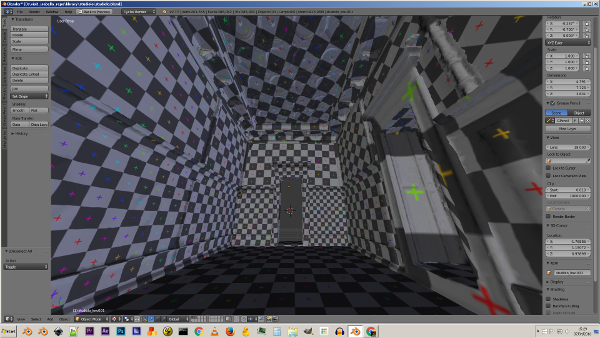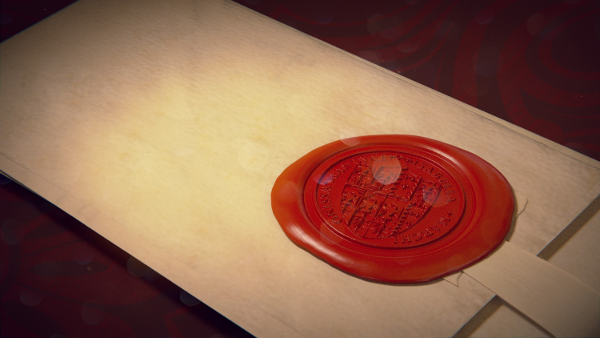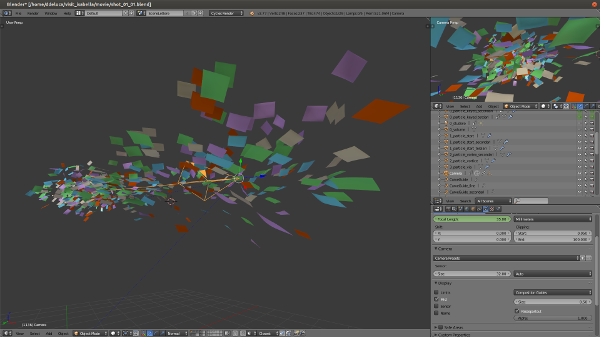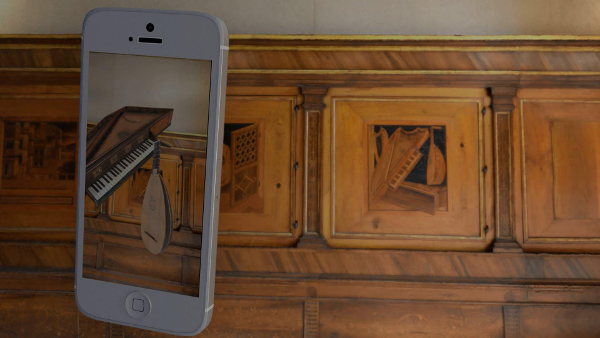Isabella d’Este: Virtual Studiolo - the video

A view of the reconstructed studiolo in its present state but with the seven paintings now at the Louvre museum
For centuries the personal studiolo (study) designed by Isabella d’Este at Mantua’s Ducal Palace
has been accessible only in dispersed pieces and in spaces depopulated of major works and artefacts.
Digital technology offers the possibility of creating a customisable virtual studiolo in which both visual and acoustic elements may be implemented and the
historical uncertainty about numerous details in Isabella’s arrangement of her collection can be managed with personalised set-up.
In anticipation of the project’s full construction and in order to present its future developments,
a concept demo-video developed within Blender has been funded by the Samuel H. Kress Foundation.
The demo-video Isabella d'Este: Virtual Studiolo, part of the IDEA: Isabella d’Este Archive project, aims to explain to potential funding agencies,
in a concise and effective manner, the attractions of a complex project such as the Virtual Studiolo.
For this purpose, we chose to produce an emotionally compelling video presenting both the historic space of the studiolo,
as a 3D reconstruction resulting from a photogrammetric campaign, and a selection of objects from the collection once housed in it.
More than 500 photos were taken inside each of Isabella’s two rooms at a 36-Megapixel resolution.
The photogrammetric reconstruction, with PhotoScan, produced the following results:
for the studiolo, starting from 574 photos, the software was able to align 574, creating a dense point cloud of 110,945,015 points with 11 million vertices and eight 4096*4096 pixel textures;
for the grotta, starting from 620 photos, the software was able to align 492, creating a dense point cloud of 122,408,100 points with 12 million vertices and four 4096*4096 pixel textures.
The 3D models, of ~12 million vertices each, were then imported and optimised in Blender.
The mesh was duplicated and divided into macro areas (ceiling, walls, floor) and further subdivided into smaller areas before applying planar and collapse decimation.
As for the textures, since PhotoScan does not optimise UV unwrap, the mesh had to be manually subdivided through seams, in order to isolate planar areas and perform a new manual unwrap through
Blender standard unwrap and project from view.
To some areas, such as those with the intarsia wooden panels or the richly coffered ceiling, we granted a higher level of resolution by scaling the UV island;
for an immediate visual feedback we applied a 4K resolution UV grid texture.
For the video, several other techniques were also used:
fluid simulation, for ink and sealing wax drops;
a series of keyed particle simulations, for the vortex with Isabella’s letters;
Blender animation nodes, for the spreading of the floor tiles;
3D photo matching with a female MakeHuman customised model of the Isabella’s portrait by Titian;
dynamic paint letter generation;
morphing techniques among layers.
The project, up to now, has shared some assets as tutorial (How to: a sealing wax stamp animation in Blender), as 3D models
(Renaissance Lute) and as timelaps (Timelapse of a renaissance lute in blender:
modeling and shading)
Technical information:
- Blender 2.76-2.77a
- Rendered with Cycles render engine
- PhotoScan Agisoft
- Make Human
- Blender Render Farm on 2.77a
- 7 scenes for a total of 31 shots
- 7000h of rendering
- Rendertime optimized from 3 to 300 seconds per frame
Production crew, historians and coordinators:
- Deanna Shemek, producer, IDEA video project lead and permissions coordinator
- Antonella Guidazzoli, executive producer, project supervisor
- Maria Chiara Liguori, project supervisor, assistant director, photogrammetric campaign
- Molly Bourne, Stephen Campbell, art historical advisors
- Lisa Regan, permissions coordinator
- Daniela Ferrari, archival assistance
Artistic and technical crew:
- Giovanni Bellavia, writer, director, animatic, color layout, editing, production manager
- Daniele De Luca, lead 3D artist and CG team leader, lighting, compositing, VFX, 3D animation, photogrammetric campaign, photomodeling, sound effects
- Luigi Verri, 3D modeling, lighting, compositing, VFX
- Silvano Imboden, Blender Render Farm, technical pipeline supervisor
- Micaela Spigarolo, storyboard
- Luca Govoni, 2D graphics
- Parrot Films, sound effects
Isabella d'Este Virtual Studiolo - work in progress from Cineca
Sample stills from the making of the video:

The photogrammetric reconstruction of the Studiolo in Mantua’s Ducal Palace, in PhotoScan

The UV grid texture applied to the studiolo 3D model within Blender

A still from the 2D animatic
_small.jpg)
The same scene as above in the final rendering

A still image of the sealing wax with Isabella d'Este's crest

Final interpolation between the particle systems, from the vortex to the explosion of the letters
_small.png)
The reconstructed tiled floor of the studiolo

Transition from an effect simulating the traditional technique for decorating ceramics and the real coloured object pertaining to Isabella's collection

Simulating an Augmented Reality application that will be developed in future phases of the project

Simulating an immersive Virtual Reality application that will be developed in future phases of the project

made with Blender




_small.jpg)


_small.png)


